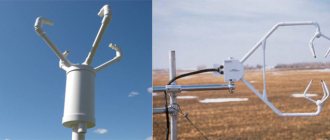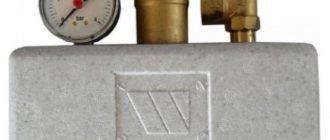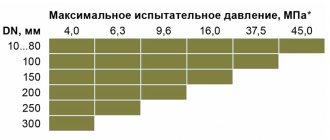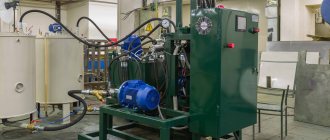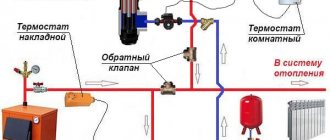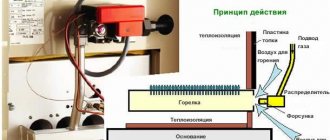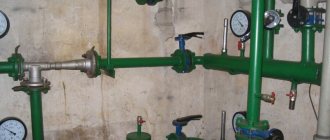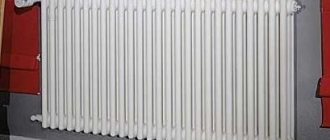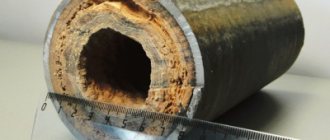Equivalent diameter
- To calculate pipes and channels of non-circular cross-section, so-called equivalent diameters are used. Also called hydrodynamic diameter in hydrodynamics itself. The pressure must act along the cross section F through which the flow flows and select the frictional force DrMp along the wet boundary. The relationship between both forces. Corresponds to the same ratio of round pipes. And then... Research by Schiller and Nikuradze showed that when using a hydraulic diameter, the law of resistance to turbulent flow, which is obtained in round pipes, remains unchanged. It is also effective for pipes of other cross-sectional shapes. Importance of Opir.
The table shows what is calculated for some common cross-sectional shapes. 19. Hydraulic diameter. Rectangle fin length A and B squared fin length around pipe OO Vertical pipe film thickness 8 Open channel width b, depth t When D is applied, Equation 160 is expected to remain a valid heat transfer equation. For round pipes, only for other cross-sectional shapes, the wet and heat transfer circumferences are equal to the heated ones.
Nevertheless, it is worth giving a description of one attempt, since it brings us closer to the path chosen by Planck to derive his law. Lyudmila Firmal
For example, for a tubular heat exchanger in a pipe, the heat transfer is equal to The inner surface of the annular gap, as well as the outer surface of the insulation, raises the question of what defining dimensions should be included in the similarity standard. It was used to give the equation of a circular pipe. Jordan proposed introducing the so-called thermal diameter o PM 4P 77BpM. Permeable section of the border. Some Authors agreed with this proposal, but insisted that the rest be retained as features. From participating in heat transfer All wetted parts Inside. The detectable inner diameter of Zls rings is around Do and D.
The heat transfer equation in an annular pipe is obtained based on the same boundary conditions of the velocity and temperature fields. However, if the part of the wall washed by the flow is insulated. Then enter u 0 and d8 dy 0 at the same time. Therefore both fields are important. Since they are very different from each other, the equations estimated for the conditions r 0 and 8-8 0 should not be expected to remain strictly valid even if they are entered into the criterion. It's similar to Ogmr. Or Otorm..
- In this sense, the ring sections with different ratios of Deidt diameters are no longer similar to each other. If you want to keep the previously obtained equations, you can Then, obviously, we need to introduce new standards such as F DjDi. Perhaps the Prandtl number should also be included in the function. The experimental results do not provide a clear answer to this question. Faust and Christian 1 received heat transfer on the inner surface of an annular pipe that was washed with water The following relationships Replace gvdr with this equation. D pm. The numerical coefficient increases to 0.04.
About O4 1.65 2.45 and 17 and Re numbers 12.000-220.000 water and air Monrad and Pelton2 give equations McAdams and his colleagues discovered water vapor in DO D4 1.52 versus 0.76 Rg 1.21 and 7000 Re 40,000. Where L is the distance from the starting point of the pipe to study area. Kirschbaum presented the results of measuring the annular gap during air cooling in the form of an equation at an initial temperature of 100-300 C. This is due to the fact that a strong influence of the input signal is permissible up to the lower limit of Re 2300. Application of Ogvlr. because the value of a increases by 30 The numerical factor should be approximately 0.025. When heating air, use Pr0. 3 instead of pr0-31.See. equation 155.
But all of them were unsuccessful in the sense that the calculations led to conclusions that did not correspond to the experimental data. Lyudmila Firmal
For an annular gap, according to formula 161, 0 M, p Og, dr 1—Da Dj, and therefore D pM, Dr f. is always greater than 2. If the half-life is equal to -O-0 3, then in an equation of the form 163 When processing measurements, instead of Dieff, the numerical coefficient is reduced in all cases. It has been replaced by OnIfl.
Calculation of air ducts for ventilation systems
Calculation of ventilation ducts is one of the stages of ventilation calculation and consists of determining the size of the air duct depending on the air flow that must pass through the duct in question. In addition, problems arise in determining the surface area of the air duct. Let's look at them in more detail.
Stage one
This includes an aerodynamic calculation of mechanical air conditioning or ventilation systems, which includes a number of sequential operations. A diagram is drawn up in axonometry, which includes ventilation: both supply and exhaust, and is prepared for calculation.
The dimensions of the cross-sectional area of the air ducts are determined depending on their type: round or rectangular.
Formation of the scheme
The diagram is drawn up in axonometry with a scale of 1:100. It indicates points with located ventilation devices and the consumption of air passing through them.
When building a highway, you should pay attention to what kind of system is being designed: supply or exhaust
Supply
Here the calculation line is lined up from the most distant air distributor with the highest consumption. It passes through supply elements such as air ducts and the ventilation unit right up to the place where the air is taken in. If the system must serve several floors, then the air distributor is located on the last one.
Exhaust
A line is built from the most remote exhaust device, which consumes the maximum air flow, through the main line to the exhaust hood installation and further to the shaft through which the air is exhausted.
If ventilation is planned for several levels and the hood installation is located on the roof or attic, then the calculation line should start from the air distribution device of the lowest floor or basement, which is also part of the system. If the hood installation is located in the basement, then from the air distribution device of the top floor.
The entire calculation line is divided into segments, each of them represents a section of the air duct with the following characteristics:
- air duct of uniform cross-sectional size;
- from one material;
- with constant air consumption.
The next step is to number the segments. It starts with the most distant exhaust device or air distributor, each being assigned a separate number. The main direction - the highway is highlighted with a thick line.
Next, based on the axonometric diagram, its length is determined for each segment, taking into account the scale and air consumption. The latter is the sum of all quantities of consumed air flow flowing through the branches that are adjacent to the main line. The value of the indicator, which is obtained as a result of sequential summation, should gradually increase.
Determination of dimensional values of air duct sections
Produced based on indicators such as:
- air consumption on the segment;
- The standard recommended values for air flow speed are: on highways - 6m/s, in mines where air is taken - 5m/s.
The preliminary dimensional value of the air duct along the segment is calculated and reduced to the nearest standard. If a rectangular duct is selected, then the values are selected based on the dimensions of the sides, the ratio between which is no more than 1 to 3.
Algorithm for calculating the cross-section of air ducts
Calculation of the cross-section of air ducts involves determining the size of the air ducts depending on the flow rate of the air passed through. It is performed in 4 stages:
- Conversion of air flow to m 3 /s
- Choosing air speed in the duct
- Determining the cross-sectional area of the duct
- Determining the diameter of a round or width and height of a rectangular duct.
At the first stage of air duct calculation, the air flow rate G, usually expressed in m 3 /hour, is converted to m 3 /s. To do this, you need to divide it by 3600:
- G [m 3 /s] = G [m 3 /hour] / 3600
At the second stage, you should set the speed of air movement in the duct. The speed should be specified, not calculated. That is, choose the air speed that seems optimal.
The high air velocity in the duct allows the use of small cross-section ducts. However, the air flow will be noisy, and the aerodynamic resistance of the air duct will greatly increase.
Basic formulas for aerodynamic calculations
The first step is to make an aerodynamic calculation of the highway. Let us remind you that the main air duct is considered to be the longest and most loaded section of the system. The fan is selected based on the results of these calculations.
Just don’t forget about linking the remaining branches of the system
It is important! If it is not possible to make connections on the branches of the air ducts within 10%, you need to use diaphragms. The diaphragm resistance coefficient is calculated using the formula:
If the discrepancy is more than 10%, when a horizontal air duct enters a vertical brick duct, rectangular diaphragms must be placed at the junction.
The main task of the calculation consists of finding the pressure loss. At the same time, I select the optimal size of the air ducts and control the air speed. The total pressure loss is the sum of two components - pressure loss along the length of the air ducts (due to friction) and losses in local resistance. They are calculated using the formulas
These formulas are correct for steel air ducts; for all others, an correction factor is introduced. It is taken from the table depending on the speed and roughness of the air ducts.
For rectangular air ducts, the calculated value is the equivalent diameter.
Let's consider the sequence of aerodynamic calculation of air ducts using the example of offices given in the previous article, using formulas. And then we’ll show you what it looks like in Excel.
Calculation example
According to calculations, the air exchange in the office is 800 m3/hour. The task was to design air ducts in offices no more than 200 mm high. The dimensions of the room are given by the customer. Air is supplied at a temperature of 20°C, air density 1.2 kg/m3.
It will be easier if the results are entered into a table of this type
First we will do an aerodynamic calculation of the main line of the system. Now everything is in order:
We divide the main line into sections along the supply grilles. We have eight grates in the room, each with a capacity of 100 m3/hour. There were 11 sections. We enter the air flow at each section into the table.
- We record the length of each section.
- The recommended maximum speed inside the duct for office premises is up to 5 m/s. Therefore, we select the size of the air duct so that the speed increases as it approaches the ventilation equipment and does not exceed the maximum. This is done to avoid noise in ventilation. Let’s take an air duct of 150x150 for the first section, and 800x250 for the last section.
V1=L/3600F =100/(3600*0.023)=1.23 m/s.
V11= 3400/3600*0.2= 4.72 m/s
We are satisfied with the result. We determine the dimensions of the air ducts and the speed using this formula in each section and enter them into the table.
We begin calculating pressure losses. We determine the equivalent diameter for each section, for example the first dе=2*150*150/(150+150)=150. Then we fill in all the data necessary for the calculation from the reference literature or calculate: Re=1.23*0.150/(15.11*10^-6)=12210. λ=0.11(68/12210+0.1/0.15)^0.25=0.0996 The roughness of different materials is different.
- Dynamic pressure Pd=1.2*1.23*1.23/2=0.9 Pa is also recorded in the column.
- From Table 2.22 we determine the specific pressure loss or calculate R=Pd*λ/d= 0.9*0.0996/0.15=0.6 Pa/m and enter it in a column. Then at each section we determine the pressure loss due to friction: ΔРtr=R*l*n=0.6*2*1=1.2 Pa.
- We take local resistance coefficients from reference literature. In the first section we have a grille and an increase in the air duct in the sum of their CMC is 1.5.
- Pressure loss in local resistances ΔРм=1.5*0.9=1.35 Pa
- We find the amount of pressure loss in each section = 1.35+1.2=2.6 Pa. And as a result, the pressure loss in the entire line = 185.6 Pa. by that time the table will look like
After this, the aerodynamic calculation can be considered complete. For round air ducts, the calculation principle is the same, only the equivalent diameter is equal to the diameter of the air duct.
Example of air duct calculation
As an example, let’s calculate the cross-section of an air duct with an air flow of 1000 m 3 /hour:
- G = 1000/3600 = 0.28 m 3 /s
- v = 4 m/s
- S = 0.28 / 4 = 0.07 m2
- In the case of a round duct, its diameter would be D = root (4·S/ π) ≈ 0.3 m = 300 mm. The nearest standard duct diameter is 315 mm.
In the case of a rectangular duct, it is necessary to select A and B such that their product is approximately 0.07. It is recommended that A and B do not differ from each other by more than three times, that is, a 700x100 air duct is not the best option. Better options: 300x250, 350x200.
Calculation of equivalent diameter of air ducts
The equivalent diameter of a rectangular duct is calculated by the formula:
- Deq_pr = 2 A B / (A + B), where A and B are the width and height of the rectangular air duct.
For example, the equivalent diameter of a 500×300 duct is 2·500·300 / (500+300) = 375 mm. This means that a 375mm round duct will have the same aerodynamic drag as a 500x300mm rectangular duct.
The equivalent diameter of a square duct is equal to the side of the square:
And this fact is very interesting, because usually the larger the cross-sectional area of the air duct, the lower its resistance. However, the round shape of the air duct section has the best aerodynamic performance. That is why the resistance of square and round ducts are equal, although the cross-sectional area of a square duct is 27% larger than the cross-sectional area of a round duct.
In general, the formula for the equivalent duct diameter is as follows:
- Deq = 4·S / P, where S and P are the area and perimeter of the air duct, respectively.
General information
Aerodynamic calculation is a technique for determining the cross-sectional dimensions of air ducts to level out pressure losses, maintain the speed of movement and the design volume of pumped air.
With the natural ventilation method, the required pressure is given initially, but the cross-section must be determined. This is due to the action of gravitational forces, which encourage air masses to be drawn into the room from the ventilation shafts. With the mechanical method, a fan operates, and it is necessary to calculate the gas pressure, as well as the cross-sectional area of the box. Maximum speeds inside the ventilation duct are used.
To simplify the technique, air masses are taken as a liquid with zero percent compression. In practice, this is true, since in most systems the pressure is minimal. It is formed only from local resistance, when it collides with the walls of the air ducts, as well as at places where the area changes. This was confirmed by numerous experiments conducted according to the methodology described in GOST 12.3.018-79 “System of Occupational Safety Standards (OSSS). Ventilation systems. Methods of aerodynamic tests".
The technique involves selecting the area and cross-sectional shape for each section of the ventilation system. If we take it as a whole, then the definition of losses will be conditional, not corresponding to the real picture. In addition to the movement itself, the injection is also calculated.
Calculations of air ducts for ventilation, based on aerodynamics, are carried out with a varying number of known data. In one case, the calculation starts from scratch, and in the other, more than half of the initial parameters are already known.
An example of calculating the equivalent diameter of air ducts and some conclusions
As an example, let's determine the equivalent diameter of the duct 600×300:
Deq_600_300 = 2 600 300 / (600+300) = 400 mm.
It is interesting to note that the cross-sectional area of a round air duct with a diameter of 400 mm is 0.126 m2, and the cross-sectional area of a 600×300 air duct is 0.18 m2, which is 42% more. The steel consumption per 1 meter of a round air duct with a cross-section of 400 mm is 1.25 m2, and for 1 meter of an air duct with a cross-section of 600×300 - 1.8 m2, which is 44% more.
Thus, any rectangular air duct similar to a round one is significantly inferior to it both in compactness and in metal consumption.
Let's consider another example - let's determine the equivalent diameter of the air duct 500×100 mm:
Deq_500_100 = 2·500·100 / (500+100) = 167 mm.
Here the difference in cross-sectional area and metal consumption reaches 2.5 times. Thus, the equivalent diameter formula for a rectangular duct explains the fact that the more “flattened” the duct is (the greater the difference between the values of A and B), the less efficient this duct is from an aerodynamic point of view.
This is one of the reasons why it is not recommended to use air ducts in ventilation technology, in the cross-section of which one side is more than three times larger than the other.
Flexible aluminum ducts
The main area of application of flexible air ducts is the connecting section between the galvanized air duct and the grille adapter, a kind of flexible liner. The fact is that the air duct and the inlet of the grille adapter are difficult to fit exactly to each other. This is where flexible ducts come to the rescue (see Figure 4). They are made of thin aluminum foil and solve the problem of misalignment of these elements.
Another area of application for flexible air ducts is to connect a kitchen hood with a ventilation shaft in apartments and private houses. Their use allows you to avoid complex adjustment of rigid air ducts, save on bends and significantly reduce the installation time of kitchen ventilation.
Figure 4. Appearance of flexible air ducts made of aluminum foil without thermal insulation (top) and with thermal insulation (bottom).
Typically, the length of connecting flexible air ducts does not exceed one to two meters. An exception is air conditioning systems with a duct-type indoor unit. Here, all wiring can be done with flexible air ducts. However, in any case, for long routes it is recommended to use galvanized air ducts - their aerodynamic resistance is 10 or more times less than that of flexible ones.
Flexible air ducts made of aluminum foil are available with or without thermal insulation. For supply systems with a cooling section, as well as on the supply air ducts of a ducted air conditioner, insulated flexible air ducts should be used. The insulation thickness of insulated flexible air ducts is usually 25 millimeters. Therefore, when using them, you should remember the actual increase in the diameter of the air duct by 50 millimeters.
Formula for calculating the area of air ducts
The area of the air ducts is determined by multiplying the perimeter of the air duct cross-section by the length of the air duct:
- S = П·L, where П and L are, respectively, the perimeter and length of the air duct in meters.
It is important to remember the dimensions of the quantities in the formula above. Typically, the duct cross-section is specified in millimeters (for example, diameter 250 or section 500×250), and the length is specified in meters (for example, 5 meters). But it is necessary to substitute all values expressed in meters into the formula. Moreover, you must first calculate the length of the perimeter of the air duct section.
To simplify the task of calculating the area of air ducts, ready-made formulas for round and rectangular air ducts are used.
